Analysis of Malnutrition Among Children from Lower SES Families
VerifiedAdded on 2021/06/15
|13
|4037
|89
Essay
AI Summary
This essay investigates the issue of malnutrition among children from lower socioeconomic status (SES) families, primarily focusing on the Australian context. It begins by defining malnutrition and highlighting its prevalence, particularly undernutrition, within this demographic, emphasizing its detrimental effects on child development, immune function, and cognitive abilities. The essay then delves into the social determinants of malnutrition, including the mother's level of education, poverty, and dependency, illustrating how these factors contribute to food insecurity and poor health outcomes. It further examines how limited access to nutritious foods, inadequate sanitation, and healthcare exacerbate the problem. Finally, the essay identifies potential stakeholders, such as the government, who could play crucial roles in addressing these social determinants and implementing holistic interventions to eliminate malnutrition and improve child health.
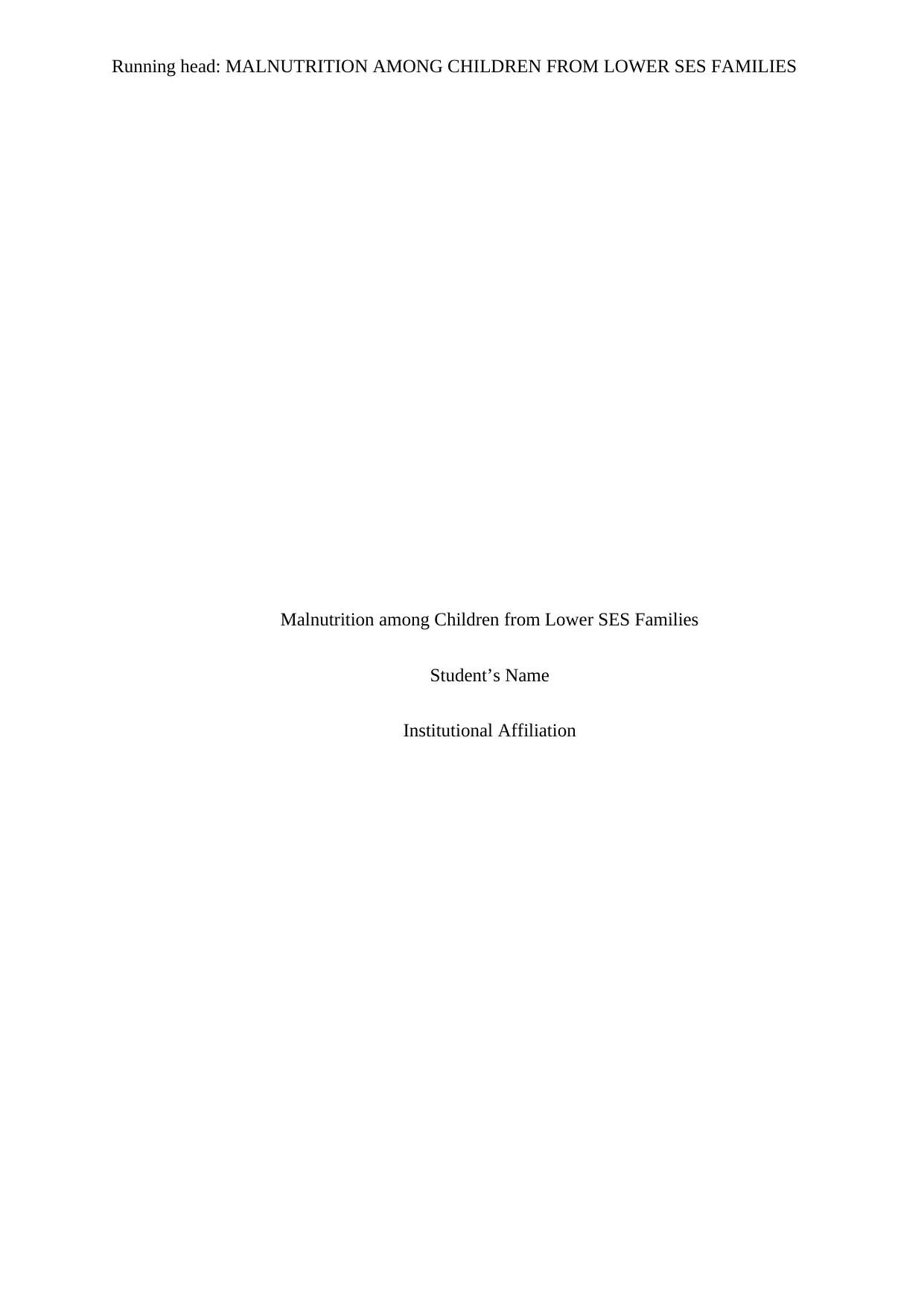
Running head: MALNUTRITION AMONG CHILDREN FROM LOWER SES FAMILIES
Malnutrition among Children from Lower SES Families
Student’s Name
Institutional Affiliation
Malnutrition among Children from Lower SES Families
Student’s Name
Institutional Affiliation
Paraphrase This Document
Need a fresh take? Get an instant paraphrase of this document with our AI Paraphraser
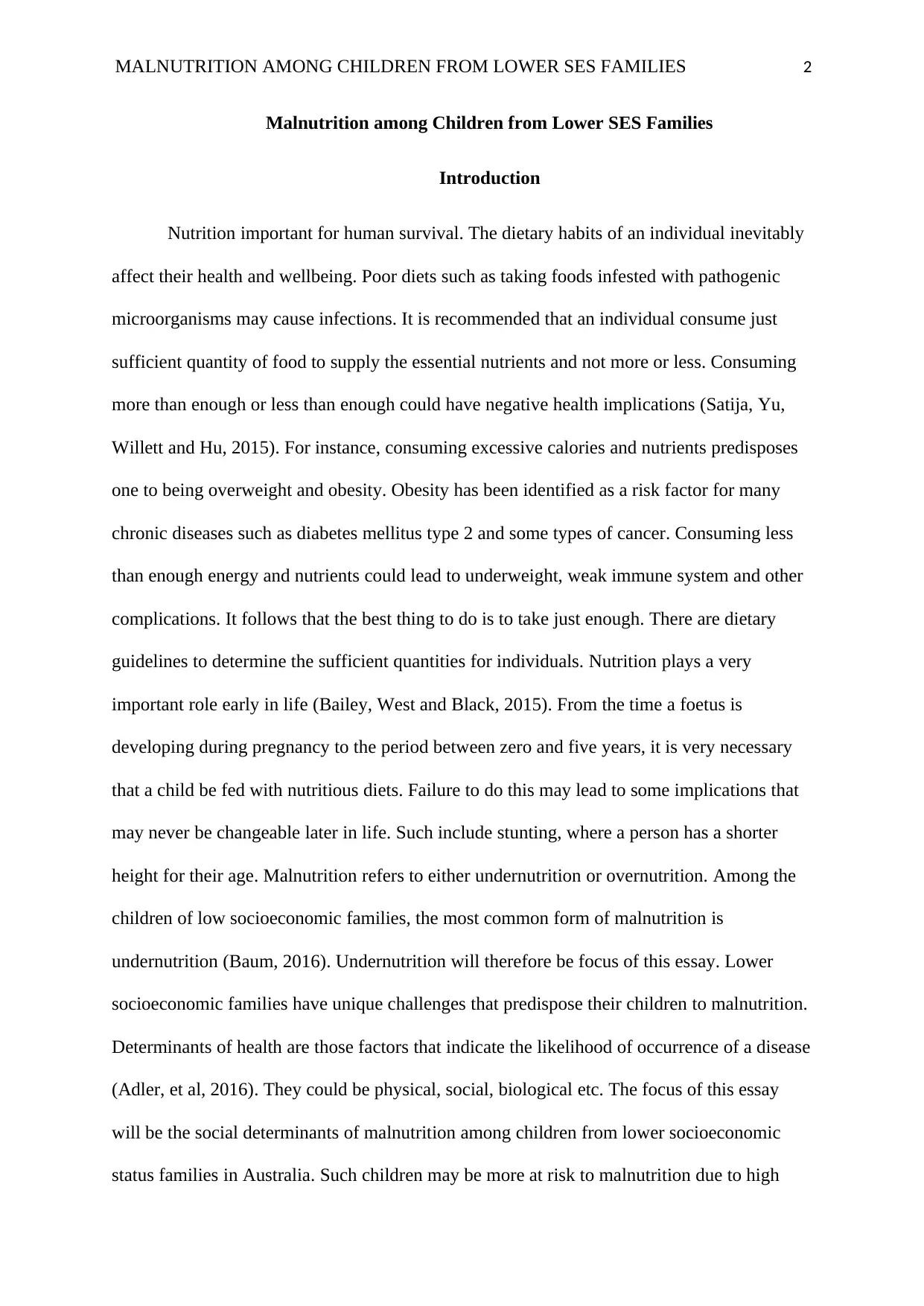
MALNUTRITION AMONG CHILDREN FROM LOWER SES FAMILIES 2
Malnutrition among Children from Lower SES Families
Introduction
Nutrition important for human survival. The dietary habits of an individual inevitably
affect their health and wellbeing. Poor diets such as taking foods infested with pathogenic
microorganisms may cause infections. It is recommended that an individual consume just
sufficient quantity of food to supply the essential nutrients and not more or less. Consuming
more than enough or less than enough could have negative health implications (Satija, Yu,
Willett and Hu, 2015). For instance, consuming excessive calories and nutrients predisposes
one to being overweight and obesity. Obesity has been identified as a risk factor for many
chronic diseases such as diabetes mellitus type 2 and some types of cancer. Consuming less
than enough energy and nutrients could lead to underweight, weak immune system and other
complications. It follows that the best thing to do is to take just enough. There are dietary
guidelines to determine the sufficient quantities for individuals. Nutrition plays a very
important role early in life (Bailey, West and Black, 2015). From the time a foetus is
developing during pregnancy to the period between zero and five years, it is very necessary
that a child be fed with nutritious diets. Failure to do this may lead to some implications that
may never be changeable later in life. Such include stunting, where a person has a shorter
height for their age. Malnutrition refers to either undernutrition or overnutrition. Among the
children of low socioeconomic families, the most common form of malnutrition is
undernutrition (Baum, 2016). Undernutrition will therefore be focus of this essay. Lower
socioeconomic families have unique challenges that predispose their children to malnutrition.
Determinants of health are those factors that indicate the likelihood of occurrence of a disease
(Adler, et al, 2016). They could be physical, social, biological etc. The focus of this essay
will be the social determinants of malnutrition among children from lower socioeconomic
status families in Australia. Such children may be more at risk to malnutrition due to high
Malnutrition among Children from Lower SES Families
Introduction
Nutrition important for human survival. The dietary habits of an individual inevitably
affect their health and wellbeing. Poor diets such as taking foods infested with pathogenic
microorganisms may cause infections. It is recommended that an individual consume just
sufficient quantity of food to supply the essential nutrients and not more or less. Consuming
more than enough or less than enough could have negative health implications (Satija, Yu,
Willett and Hu, 2015). For instance, consuming excessive calories and nutrients predisposes
one to being overweight and obesity. Obesity has been identified as a risk factor for many
chronic diseases such as diabetes mellitus type 2 and some types of cancer. Consuming less
than enough energy and nutrients could lead to underweight, weak immune system and other
complications. It follows that the best thing to do is to take just enough. There are dietary
guidelines to determine the sufficient quantities for individuals. Nutrition plays a very
important role early in life (Bailey, West and Black, 2015). From the time a foetus is
developing during pregnancy to the period between zero and five years, it is very necessary
that a child be fed with nutritious diets. Failure to do this may lead to some implications that
may never be changeable later in life. Such include stunting, where a person has a shorter
height for their age. Malnutrition refers to either undernutrition or overnutrition. Among the
children of low socioeconomic families, the most common form of malnutrition is
undernutrition (Baum, 2016). Undernutrition will therefore be focus of this essay. Lower
socioeconomic families have unique challenges that predispose their children to malnutrition.
Determinants of health are those factors that indicate the likelihood of occurrence of a disease
(Adler, et al, 2016). They could be physical, social, biological etc. The focus of this essay
will be the social determinants of malnutrition among children from lower socioeconomic
status families in Australia. Such children may be more at risk to malnutrition due to high
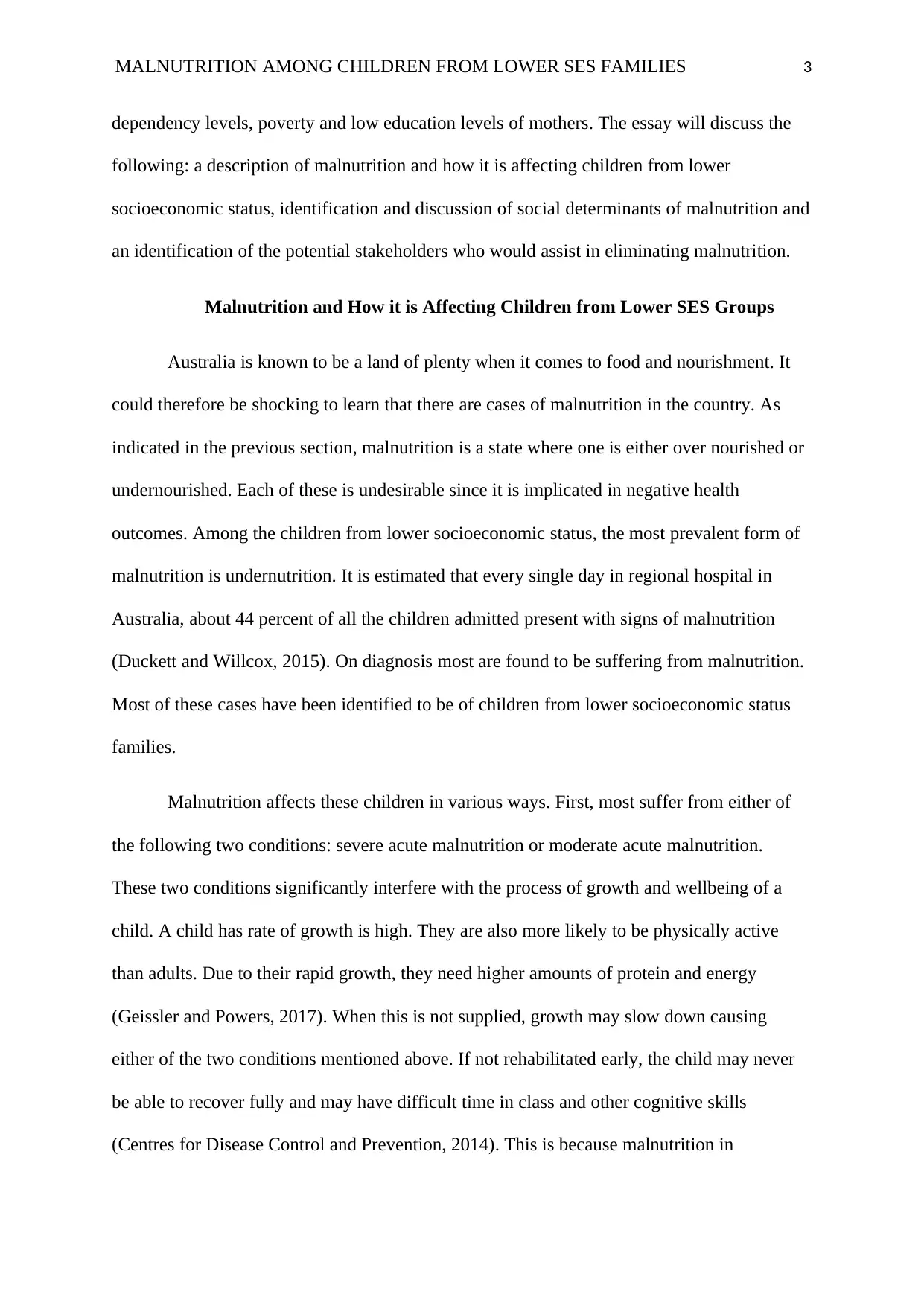
MALNUTRITION AMONG CHILDREN FROM LOWER SES FAMILIES 3
dependency levels, poverty and low education levels of mothers. The essay will discuss the
following: a description of malnutrition and how it is affecting children from lower
socioeconomic status, identification and discussion of social determinants of malnutrition and
an identification of the potential stakeholders who would assist in eliminating malnutrition.
Malnutrition and How it is Affecting Children from Lower SES Groups
Australia is known to be a land of plenty when it comes to food and nourishment. It
could therefore be shocking to learn that there are cases of malnutrition in the country. As
indicated in the previous section, malnutrition is a state where one is either over nourished or
undernourished. Each of these is undesirable since it is implicated in negative health
outcomes. Among the children from lower socioeconomic status, the most prevalent form of
malnutrition is undernutrition. It is estimated that every single day in regional hospital in
Australia, about 44 percent of all the children admitted present with signs of malnutrition
(Duckett and Willcox, 2015). On diagnosis most are found to be suffering from malnutrition.
Most of these cases have been identified to be of children from lower socioeconomic status
families.
Malnutrition affects these children in various ways. First, most suffer from either of
the following two conditions: severe acute malnutrition or moderate acute malnutrition.
These two conditions significantly interfere with the process of growth and wellbeing of a
child. A child has rate of growth is high. They are also more likely to be physically active
than adults. Due to their rapid growth, they need higher amounts of protein and energy
(Geissler and Powers, 2017). When this is not supplied, growth may slow down causing
either of the two conditions mentioned above. If not rehabilitated early, the child may never
be able to recover fully and may have difficult time in class and other cognitive skills
(Centres for Disease Control and Prevention, 2014). This is because malnutrition in
dependency levels, poverty and low education levels of mothers. The essay will discuss the
following: a description of malnutrition and how it is affecting children from lower
socioeconomic status, identification and discussion of social determinants of malnutrition and
an identification of the potential stakeholders who would assist in eliminating malnutrition.
Malnutrition and How it is Affecting Children from Lower SES Groups
Australia is known to be a land of plenty when it comes to food and nourishment. It
could therefore be shocking to learn that there are cases of malnutrition in the country. As
indicated in the previous section, malnutrition is a state where one is either over nourished or
undernourished. Each of these is undesirable since it is implicated in negative health
outcomes. Among the children from lower socioeconomic status, the most prevalent form of
malnutrition is undernutrition. It is estimated that every single day in regional hospital in
Australia, about 44 percent of all the children admitted present with signs of malnutrition
(Duckett and Willcox, 2015). On diagnosis most are found to be suffering from malnutrition.
Most of these cases have been identified to be of children from lower socioeconomic status
families.
Malnutrition affects these children in various ways. First, most suffer from either of
the following two conditions: severe acute malnutrition or moderate acute malnutrition.
These two conditions significantly interfere with the process of growth and wellbeing of a
child. A child has rate of growth is high. They are also more likely to be physically active
than adults. Due to their rapid growth, they need higher amounts of protein and energy
(Geissler and Powers, 2017). When this is not supplied, growth may slow down causing
either of the two conditions mentioned above. If not rehabilitated early, the child may never
be able to recover fully and may have difficult time in class and other cognitive skills
(Centres for Disease Control and Prevention, 2014). This is because malnutrition in
⊘ This is a preview!⊘
Do you want full access?
Subscribe today to unlock all pages.

Trusted by 1+ million students worldwide

MALNUTRITION AMONG CHILDREN FROM LOWER SES FAMILIES 4
childhood has been associated with lower intelligent quotients. Severe acute malnutrition is
manageable, but its complications claim a no of lives of children. Apart from these effects,
malnutrition and especially undernutrition causes a child to have a weakened immune system
(Moeeni, 2014). With a weakened immune system, the child becomes more susceptible to
other diseases. The immune system is involved in fighting any foreign material such as
diseases causing pathogen once they find their way to the body. A stronger immune system
will mean a greater fight against diseases while a weakened one increases the chance of
getting an infection (Whitney and Rolfes, 2018). Since malnutrition has been associated with
poor academic performance, a vicious cycle of poverty has been observed among the lower
socioeconomic families. A good education creates opportunities for greener pastures,
however, among these families most children do not perform well in school meaning that
they are likely to form a vicious cycle of poverty. Malnutrition has also been found to cause
absenteeism in school. Children could either be involved in some economic activities or be in
a health care facility. These two factors make them absent from school.
Social Determinants of Malnutrition among Children of Lower SES Families
There are many factors that paly together to contribute to malnutrition among children
in lower SES families. The UNICEF’s conceptual framework indicates that there are both
underlying and immediate factors that cause malnutrition. For malnutrition to be curbed
effectively, it is necessary to identify all the underlying and immediate causes of malnutrition
and deal with them. If that were to happen, malnutrition would probably be eradicated. In this
section, the social determinants of malnutrition will be discussed.
One of the social determinant of health among children is the education level of the
mother. Extensive research has demonstrated that the level of education of the mother affects
food choices (Rolfes, Pinna and Whitney, 2014). The higher the level of education, the
childhood has been associated with lower intelligent quotients. Severe acute malnutrition is
manageable, but its complications claim a no of lives of children. Apart from these effects,
malnutrition and especially undernutrition causes a child to have a weakened immune system
(Moeeni, 2014). With a weakened immune system, the child becomes more susceptible to
other diseases. The immune system is involved in fighting any foreign material such as
diseases causing pathogen once they find their way to the body. A stronger immune system
will mean a greater fight against diseases while a weakened one increases the chance of
getting an infection (Whitney and Rolfes, 2018). Since malnutrition has been associated with
poor academic performance, a vicious cycle of poverty has been observed among the lower
socioeconomic families. A good education creates opportunities for greener pastures,
however, among these families most children do not perform well in school meaning that
they are likely to form a vicious cycle of poverty. Malnutrition has also been found to cause
absenteeism in school. Children could either be involved in some economic activities or be in
a health care facility. These two factors make them absent from school.
Social Determinants of Malnutrition among Children of Lower SES Families
There are many factors that paly together to contribute to malnutrition among children
in lower SES families. The UNICEF’s conceptual framework indicates that there are both
underlying and immediate factors that cause malnutrition. For malnutrition to be curbed
effectively, it is necessary to identify all the underlying and immediate causes of malnutrition
and deal with them. If that were to happen, malnutrition would probably be eradicated. In this
section, the social determinants of malnutrition will be discussed.
One of the social determinant of health among children is the education level of the
mother. Extensive research has demonstrated that the level of education of the mother affects
food choices (Rolfes, Pinna and Whitney, 2014). The higher the level of education, the
Paraphrase This Document
Need a fresh take? Get an instant paraphrase of this document with our AI Paraphraser
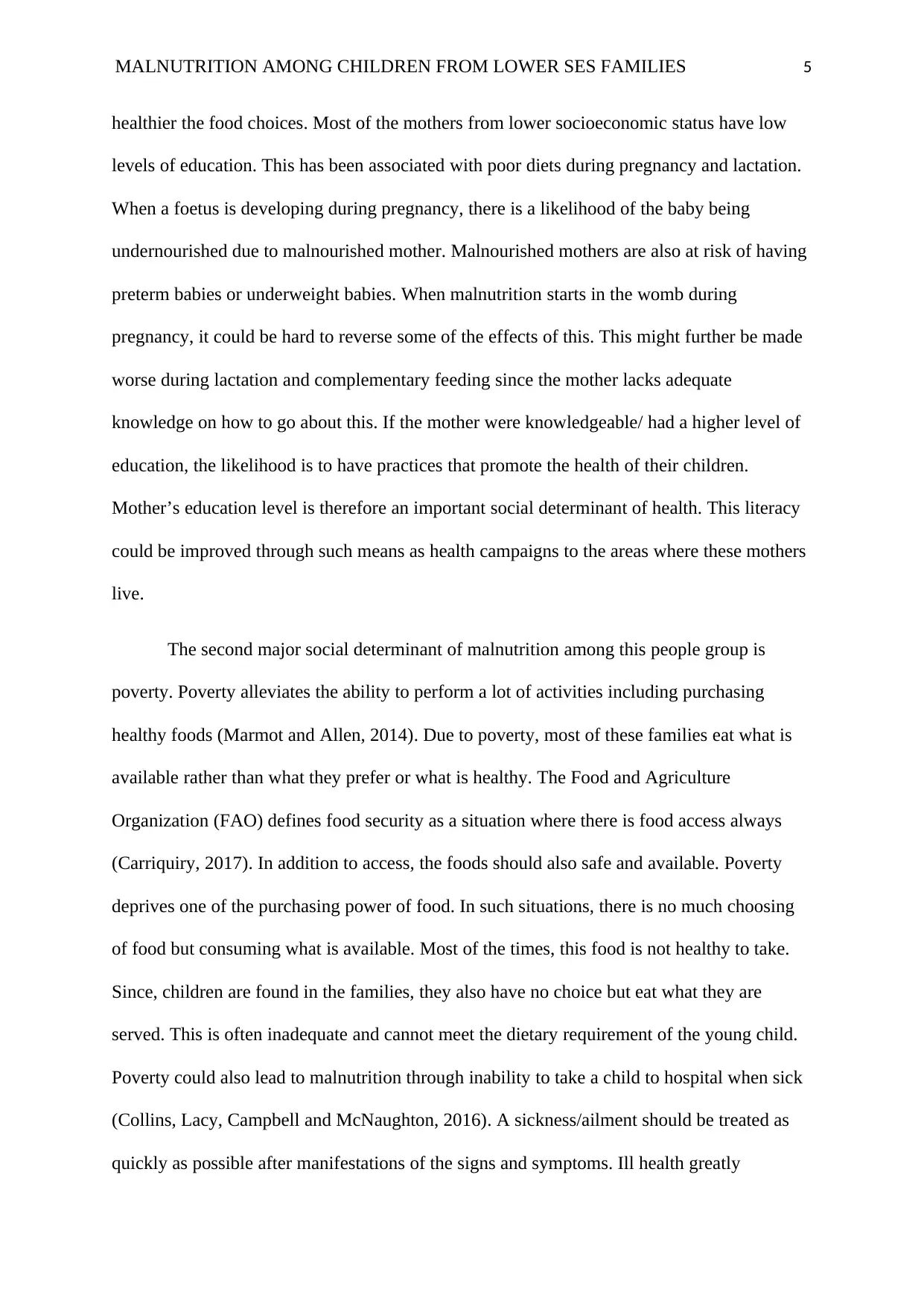
MALNUTRITION AMONG CHILDREN FROM LOWER SES FAMILIES 5
healthier the food choices. Most of the mothers from lower socioeconomic status have low
levels of education. This has been associated with poor diets during pregnancy and lactation.
When a foetus is developing during pregnancy, there is a likelihood of the baby being
undernourished due to malnourished mother. Malnourished mothers are also at risk of having
preterm babies or underweight babies. When malnutrition starts in the womb during
pregnancy, it could be hard to reverse some of the effects of this. This might further be made
worse during lactation and complementary feeding since the mother lacks adequate
knowledge on how to go about this. If the mother were knowledgeable/ had a higher level of
education, the likelihood is to have practices that promote the health of their children.
Mother’s education level is therefore an important social determinant of health. This literacy
could be improved through such means as health campaigns to the areas where these mothers
live.
The second major social determinant of malnutrition among this people group is
poverty. Poverty alleviates the ability to perform a lot of activities including purchasing
healthy foods (Marmot and Allen, 2014). Due to poverty, most of these families eat what is
available rather than what they prefer or what is healthy. The Food and Agriculture
Organization (FAO) defines food security as a situation where there is food access always
(Carriquiry, 2017). In addition to access, the foods should also safe and available. Poverty
deprives one of the purchasing power of food. In such situations, there is no much choosing
of food but consuming what is available. Most of the times, this food is not healthy to take.
Since, children are found in the families, they also have no choice but eat what they are
served. This is often inadequate and cannot meet the dietary requirement of the young child.
Poverty could also lead to malnutrition through inability to take a child to hospital when sick
(Collins, Lacy, Campbell and McNaughton, 2016). A sickness/ailment should be treated as
quickly as possible after manifestations of the signs and symptoms. Ill health greatly
healthier the food choices. Most of the mothers from lower socioeconomic status have low
levels of education. This has been associated with poor diets during pregnancy and lactation.
When a foetus is developing during pregnancy, there is a likelihood of the baby being
undernourished due to malnourished mother. Malnourished mothers are also at risk of having
preterm babies or underweight babies. When malnutrition starts in the womb during
pregnancy, it could be hard to reverse some of the effects of this. This might further be made
worse during lactation and complementary feeding since the mother lacks adequate
knowledge on how to go about this. If the mother were knowledgeable/ had a higher level of
education, the likelihood is to have practices that promote the health of their children.
Mother’s education level is therefore an important social determinant of health. This literacy
could be improved through such means as health campaigns to the areas where these mothers
live.
The second major social determinant of malnutrition among this people group is
poverty. Poverty alleviates the ability to perform a lot of activities including purchasing
healthy foods (Marmot and Allen, 2014). Due to poverty, most of these families eat what is
available rather than what they prefer or what is healthy. The Food and Agriculture
Organization (FAO) defines food security as a situation where there is food access always
(Carriquiry, 2017). In addition to access, the foods should also safe and available. Poverty
deprives one of the purchasing power of food. In such situations, there is no much choosing
of food but consuming what is available. Most of the times, this food is not healthy to take.
Since, children are found in the families, they also have no choice but eat what they are
served. This is often inadequate and cannot meet the dietary requirement of the young child.
Poverty could also lead to malnutrition through inability to take a child to hospital when sick
(Collins, Lacy, Campbell and McNaughton, 2016). A sickness/ailment should be treated as
quickly as possible after manifestations of the signs and symptoms. Ill health greatly
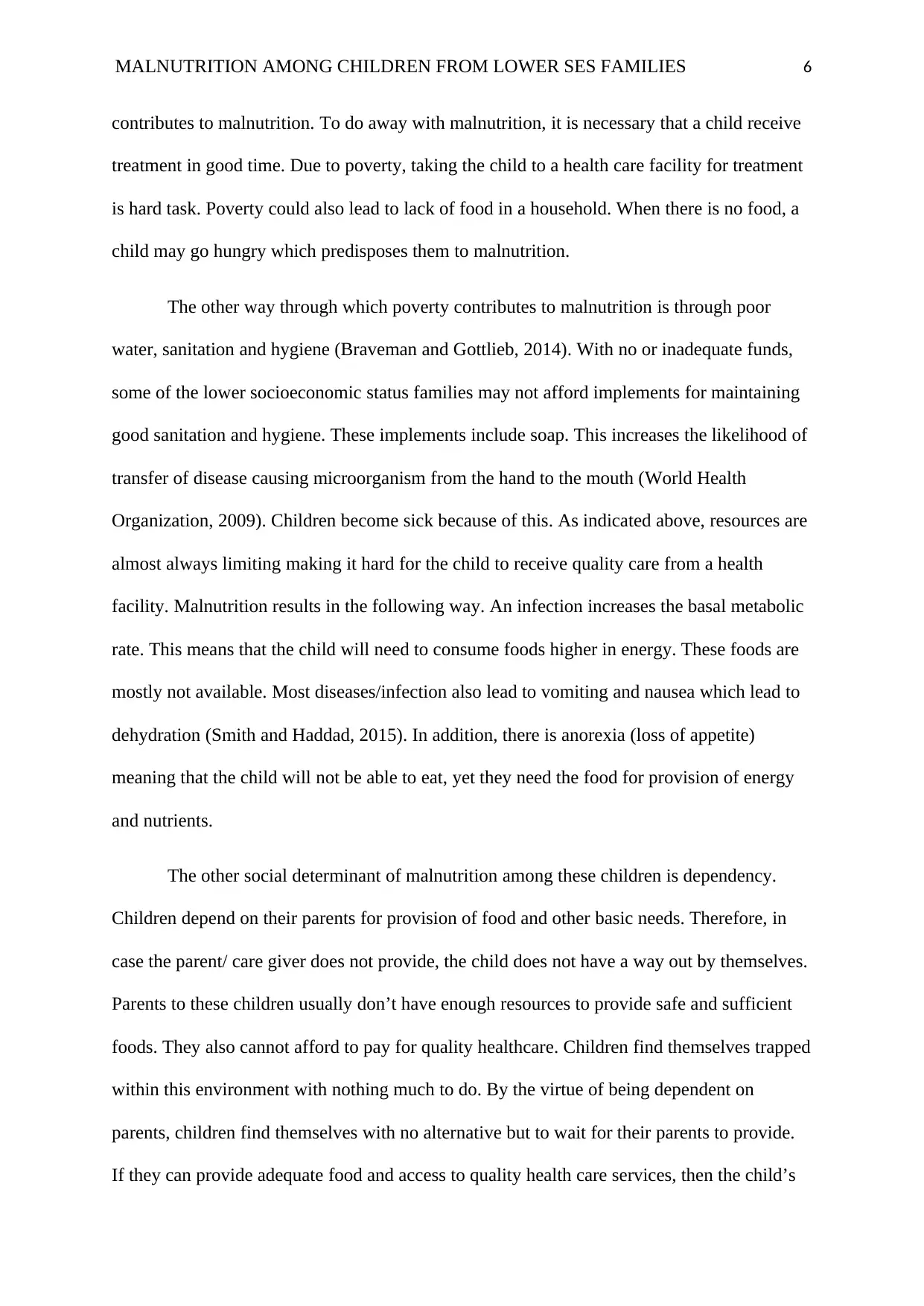
MALNUTRITION AMONG CHILDREN FROM LOWER SES FAMILIES 6
contributes to malnutrition. To do away with malnutrition, it is necessary that a child receive
treatment in good time. Due to poverty, taking the child to a health care facility for treatment
is hard task. Poverty could also lead to lack of food in a household. When there is no food, a
child may go hungry which predisposes them to malnutrition.
The other way through which poverty contributes to malnutrition is through poor
water, sanitation and hygiene (Braveman and Gottlieb, 2014). With no or inadequate funds,
some of the lower socioeconomic status families may not afford implements for maintaining
good sanitation and hygiene. These implements include soap. This increases the likelihood of
transfer of disease causing microorganism from the hand to the mouth (World Health
Organization, 2009). Children become sick because of this. As indicated above, resources are
almost always limiting making it hard for the child to receive quality care from a health
facility. Malnutrition results in the following way. An infection increases the basal metabolic
rate. This means that the child will need to consume foods higher in energy. These foods are
mostly not available. Most diseases/infection also lead to vomiting and nausea which lead to
dehydration (Smith and Haddad, 2015). In addition, there is anorexia (loss of appetite)
meaning that the child will not be able to eat, yet they need the food for provision of energy
and nutrients.
The other social determinant of malnutrition among these children is dependency.
Children depend on their parents for provision of food and other basic needs. Therefore, in
case the parent/ care giver does not provide, the child does not have a way out by themselves.
Parents to these children usually don’t have enough resources to provide safe and sufficient
foods. They also cannot afford to pay for quality healthcare. Children find themselves trapped
within this environment with nothing much to do. By the virtue of being dependent on
parents, children find themselves with no alternative but to wait for their parents to provide.
If they can provide adequate food and access to quality health care services, then the child’s
contributes to malnutrition. To do away with malnutrition, it is necessary that a child receive
treatment in good time. Due to poverty, taking the child to a health care facility for treatment
is hard task. Poverty could also lead to lack of food in a household. When there is no food, a
child may go hungry which predisposes them to malnutrition.
The other way through which poverty contributes to malnutrition is through poor
water, sanitation and hygiene (Braveman and Gottlieb, 2014). With no or inadequate funds,
some of the lower socioeconomic status families may not afford implements for maintaining
good sanitation and hygiene. These implements include soap. This increases the likelihood of
transfer of disease causing microorganism from the hand to the mouth (World Health
Organization, 2009). Children become sick because of this. As indicated above, resources are
almost always limiting making it hard for the child to receive quality care from a health
facility. Malnutrition results in the following way. An infection increases the basal metabolic
rate. This means that the child will need to consume foods higher in energy. These foods are
mostly not available. Most diseases/infection also lead to vomiting and nausea which lead to
dehydration (Smith and Haddad, 2015). In addition, there is anorexia (loss of appetite)
meaning that the child will not be able to eat, yet they need the food for provision of energy
and nutrients.
The other social determinant of malnutrition among these children is dependency.
Children depend on their parents for provision of food and other basic needs. Therefore, in
case the parent/ care giver does not provide, the child does not have a way out by themselves.
Parents to these children usually don’t have enough resources to provide safe and sufficient
foods. They also cannot afford to pay for quality healthcare. Children find themselves trapped
within this environment with nothing much to do. By the virtue of being dependent on
parents, children find themselves with no alternative but to wait for their parents to provide.
If they can provide adequate food and access to quality health care services, then the child’s
⊘ This is a preview!⊘
Do you want full access?
Subscribe today to unlock all pages.

Trusted by 1+ million students worldwide

MALNUTRITION AMONG CHILDREN FROM LOWER SES FAMILIES 7
nutrition status improves. On the other hand, inability of the parents/caregivers to provide
will predispose the child to malnutrition.
The environment in which the family lives will affect the nutrition status of a child
(Thompson and Manore, 2015). Most of the lower socioeconomic families live in an
environment where fruits and vegetables are not easily accessible. If accessible, they are in
little amounts and sold for a relatively high cost. For this reason, there is no or little
consumption of fruits and vegetables by the child. According to Rubin (2016), fruits and
vegetables are very important especially in providing micronutrients (vitamins and minerals).
Deficiency in micronutrients could also lead to malnutrition which will manifest as
micronutrient deficiencies. These deficiencies could be serious and life threatening if severe
(Gödecke, Stein and Qaim, 2018).
Potential Stake Holders to Work with to Address the Social Determinants of
Health
Several stakeholders could play a part in addressing the social determinants of
malnutrition discussed in the previous section. It is also true that to completely deal with
these determinants and reduce the negative health effects, there is great need to employ a
holistic approach. Such an approach looks at not only immediate causes of malnutrition but
also the underlying factors. In this section the role of different stake holders in ensuring such
an approach is in place will be discussed.
One of the main stake holders is the government. The government could play a great
role in eradicating malnutrition through addressing the social determinants. This can be done
through several ways. Since the government is the main law and policy making body, it could
endeavour to make laws and policies that favour an environment free of malnutrition. For
instance, there could be a policy to ensure that safe and sufficient food is available to all
nutrition status improves. On the other hand, inability of the parents/caregivers to provide
will predispose the child to malnutrition.
The environment in which the family lives will affect the nutrition status of a child
(Thompson and Manore, 2015). Most of the lower socioeconomic families live in an
environment where fruits and vegetables are not easily accessible. If accessible, they are in
little amounts and sold for a relatively high cost. For this reason, there is no or little
consumption of fruits and vegetables by the child. According to Rubin (2016), fruits and
vegetables are very important especially in providing micronutrients (vitamins and minerals).
Deficiency in micronutrients could also lead to malnutrition which will manifest as
micronutrient deficiencies. These deficiencies could be serious and life threatening if severe
(Gödecke, Stein and Qaim, 2018).
Potential Stake Holders to Work with to Address the Social Determinants of
Health
Several stakeholders could play a part in addressing the social determinants of
malnutrition discussed in the previous section. It is also true that to completely deal with
these determinants and reduce the negative health effects, there is great need to employ a
holistic approach. Such an approach looks at not only immediate causes of malnutrition but
also the underlying factors. In this section the role of different stake holders in ensuring such
an approach is in place will be discussed.
One of the main stake holders is the government. The government could play a great
role in eradicating malnutrition through addressing the social determinants. This can be done
through several ways. Since the government is the main law and policy making body, it could
endeavour to make laws and policies that favour an environment free of malnutrition. For
instance, there could be a policy to ensure that safe and sufficient food is available to all
Paraphrase This Document
Need a fresh take? Get an instant paraphrase of this document with our AI Paraphraser
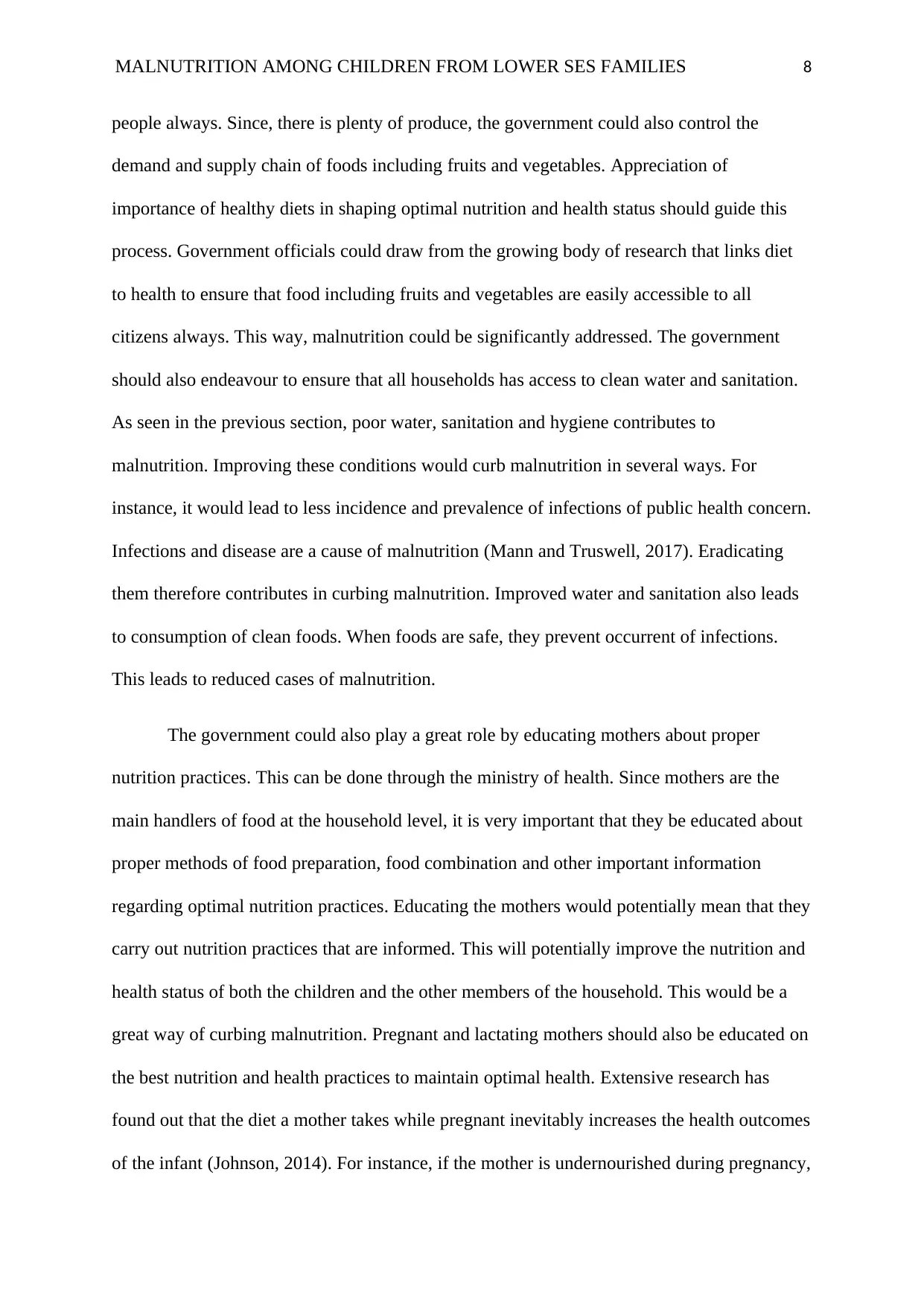
MALNUTRITION AMONG CHILDREN FROM LOWER SES FAMILIES 8
people always. Since, there is plenty of produce, the government could also control the
demand and supply chain of foods including fruits and vegetables. Appreciation of
importance of healthy diets in shaping optimal nutrition and health status should guide this
process. Government officials could draw from the growing body of research that links diet
to health to ensure that food including fruits and vegetables are easily accessible to all
citizens always. This way, malnutrition could be significantly addressed. The government
should also endeavour to ensure that all households has access to clean water and sanitation.
As seen in the previous section, poor water, sanitation and hygiene contributes to
malnutrition. Improving these conditions would curb malnutrition in several ways. For
instance, it would lead to less incidence and prevalence of infections of public health concern.
Infections and disease are a cause of malnutrition (Mann and Truswell, 2017). Eradicating
them therefore contributes in curbing malnutrition. Improved water and sanitation also leads
to consumption of clean foods. When foods are safe, they prevent occurrent of infections.
This leads to reduced cases of malnutrition.
The government could also play a great role by educating mothers about proper
nutrition practices. This can be done through the ministry of health. Since mothers are the
main handlers of food at the household level, it is very important that they be educated about
proper methods of food preparation, food combination and other important information
regarding optimal nutrition practices. Educating the mothers would potentially mean that they
carry out nutrition practices that are informed. This will potentially improve the nutrition and
health status of both the children and the other members of the household. This would be a
great way of curbing malnutrition. Pregnant and lactating mothers should also be educated on
the best nutrition and health practices to maintain optimal health. Extensive research has
found out that the diet a mother takes while pregnant inevitably increases the health outcomes
of the infant (Johnson, 2014). For instance, if the mother is undernourished during pregnancy,
people always. Since, there is plenty of produce, the government could also control the
demand and supply chain of foods including fruits and vegetables. Appreciation of
importance of healthy diets in shaping optimal nutrition and health status should guide this
process. Government officials could draw from the growing body of research that links diet
to health to ensure that food including fruits and vegetables are easily accessible to all
citizens always. This way, malnutrition could be significantly addressed. The government
should also endeavour to ensure that all households has access to clean water and sanitation.
As seen in the previous section, poor water, sanitation and hygiene contributes to
malnutrition. Improving these conditions would curb malnutrition in several ways. For
instance, it would lead to less incidence and prevalence of infections of public health concern.
Infections and disease are a cause of malnutrition (Mann and Truswell, 2017). Eradicating
them therefore contributes in curbing malnutrition. Improved water and sanitation also leads
to consumption of clean foods. When foods are safe, they prevent occurrent of infections.
This leads to reduced cases of malnutrition.
The government could also play a great role by educating mothers about proper
nutrition practices. This can be done through the ministry of health. Since mothers are the
main handlers of food at the household level, it is very important that they be educated about
proper methods of food preparation, food combination and other important information
regarding optimal nutrition practices. Educating the mothers would potentially mean that they
carry out nutrition practices that are informed. This will potentially improve the nutrition and
health status of both the children and the other members of the household. This would be a
great way of curbing malnutrition. Pregnant and lactating mothers should also be educated on
the best nutrition and health practices to maintain optimal health. Extensive research has
found out that the diet a mother takes while pregnant inevitably increases the health outcomes
of the infant (Johnson, 2014). For instance, if the mother is undernourished during pregnancy,
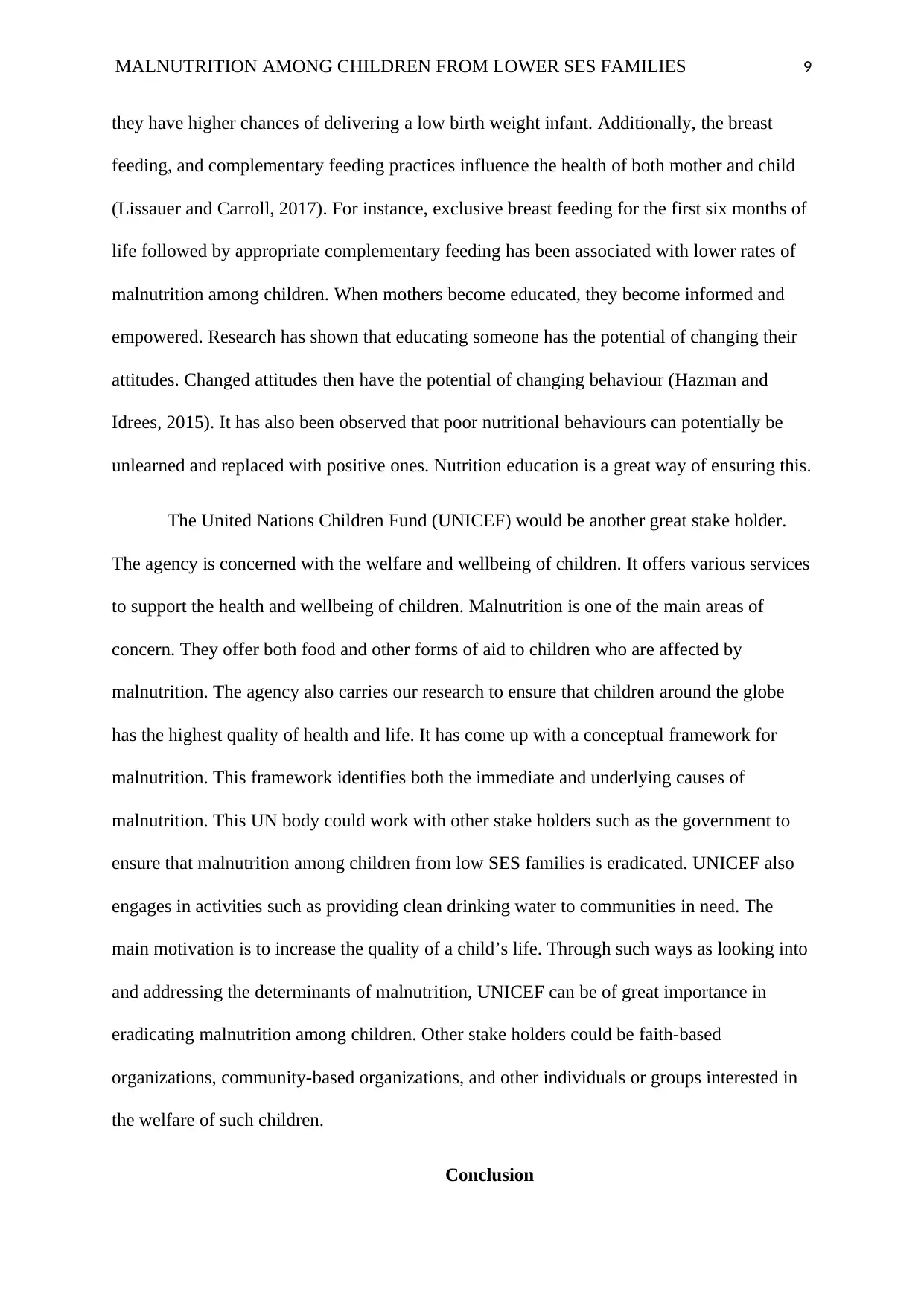
MALNUTRITION AMONG CHILDREN FROM LOWER SES FAMILIES 9
they have higher chances of delivering a low birth weight infant. Additionally, the breast
feeding, and complementary feeding practices influence the health of both mother and child
(Lissauer and Carroll, 2017). For instance, exclusive breast feeding for the first six months of
life followed by appropriate complementary feeding has been associated with lower rates of
malnutrition among children. When mothers become educated, they become informed and
empowered. Research has shown that educating someone has the potential of changing their
attitudes. Changed attitudes then have the potential of changing behaviour (Hazman and
Idrees, 2015). It has also been observed that poor nutritional behaviours can potentially be
unlearned and replaced with positive ones. Nutrition education is a great way of ensuring this.
The United Nations Children Fund (UNICEF) would be another great stake holder.
The agency is concerned with the welfare and wellbeing of children. It offers various services
to support the health and wellbeing of children. Malnutrition is one of the main areas of
concern. They offer both food and other forms of aid to children who are affected by
malnutrition. The agency also carries our research to ensure that children around the globe
has the highest quality of health and life. It has come up with a conceptual framework for
malnutrition. This framework identifies both the immediate and underlying causes of
malnutrition. This UN body could work with other stake holders such as the government to
ensure that malnutrition among children from low SES families is eradicated. UNICEF also
engages in activities such as providing clean drinking water to communities in need. The
main motivation is to increase the quality of a child’s life. Through such ways as looking into
and addressing the determinants of malnutrition, UNICEF can be of great importance in
eradicating malnutrition among children. Other stake holders could be faith-based
organizations, community-based organizations, and other individuals or groups interested in
the welfare of such children.
Conclusion
they have higher chances of delivering a low birth weight infant. Additionally, the breast
feeding, and complementary feeding practices influence the health of both mother and child
(Lissauer and Carroll, 2017). For instance, exclusive breast feeding for the first six months of
life followed by appropriate complementary feeding has been associated with lower rates of
malnutrition among children. When mothers become educated, they become informed and
empowered. Research has shown that educating someone has the potential of changing their
attitudes. Changed attitudes then have the potential of changing behaviour (Hazman and
Idrees, 2015). It has also been observed that poor nutritional behaviours can potentially be
unlearned and replaced with positive ones. Nutrition education is a great way of ensuring this.
The United Nations Children Fund (UNICEF) would be another great stake holder.
The agency is concerned with the welfare and wellbeing of children. It offers various services
to support the health and wellbeing of children. Malnutrition is one of the main areas of
concern. They offer both food and other forms of aid to children who are affected by
malnutrition. The agency also carries our research to ensure that children around the globe
has the highest quality of health and life. It has come up with a conceptual framework for
malnutrition. This framework identifies both the immediate and underlying causes of
malnutrition. This UN body could work with other stake holders such as the government to
ensure that malnutrition among children from low SES families is eradicated. UNICEF also
engages in activities such as providing clean drinking water to communities in need. The
main motivation is to increase the quality of a child’s life. Through such ways as looking into
and addressing the determinants of malnutrition, UNICEF can be of great importance in
eradicating malnutrition among children. Other stake holders could be faith-based
organizations, community-based organizations, and other individuals or groups interested in
the welfare of such children.
Conclusion
⊘ This is a preview!⊘
Do you want full access?
Subscribe today to unlock all pages.

Trusted by 1+ million students worldwide
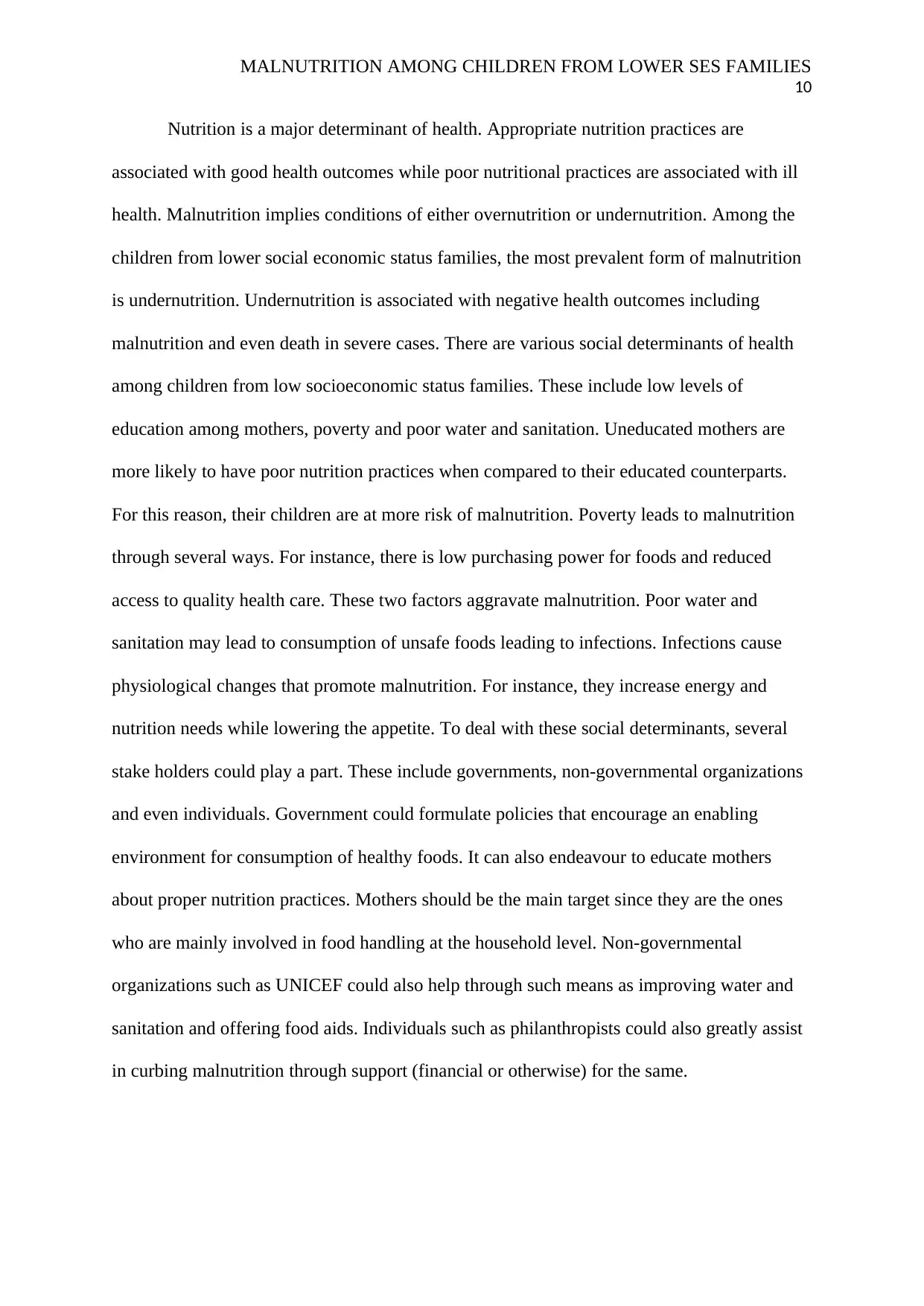
MALNUTRITION AMONG CHILDREN FROM LOWER SES FAMILIES
10
Nutrition is a major determinant of health. Appropriate nutrition practices are
associated with good health outcomes while poor nutritional practices are associated with ill
health. Malnutrition implies conditions of either overnutrition or undernutrition. Among the
children from lower social economic status families, the most prevalent form of malnutrition
is undernutrition. Undernutrition is associated with negative health outcomes including
malnutrition and even death in severe cases. There are various social determinants of health
among children from low socioeconomic status families. These include low levels of
education among mothers, poverty and poor water and sanitation. Uneducated mothers are
more likely to have poor nutrition practices when compared to their educated counterparts.
For this reason, their children are at more risk of malnutrition. Poverty leads to malnutrition
through several ways. For instance, there is low purchasing power for foods and reduced
access to quality health care. These two factors aggravate malnutrition. Poor water and
sanitation may lead to consumption of unsafe foods leading to infections. Infections cause
physiological changes that promote malnutrition. For instance, they increase energy and
nutrition needs while lowering the appetite. To deal with these social determinants, several
stake holders could play a part. These include governments, non-governmental organizations
and even individuals. Government could formulate policies that encourage an enabling
environment for consumption of healthy foods. It can also endeavour to educate mothers
about proper nutrition practices. Mothers should be the main target since they are the ones
who are mainly involved in food handling at the household level. Non-governmental
organizations such as UNICEF could also help through such means as improving water and
sanitation and offering food aids. Individuals such as philanthropists could also greatly assist
in curbing malnutrition through support (financial or otherwise) for the same.
10
Nutrition is a major determinant of health. Appropriate nutrition practices are
associated with good health outcomes while poor nutritional practices are associated with ill
health. Malnutrition implies conditions of either overnutrition or undernutrition. Among the
children from lower social economic status families, the most prevalent form of malnutrition
is undernutrition. Undernutrition is associated with negative health outcomes including
malnutrition and even death in severe cases. There are various social determinants of health
among children from low socioeconomic status families. These include low levels of
education among mothers, poverty and poor water and sanitation. Uneducated mothers are
more likely to have poor nutrition practices when compared to their educated counterparts.
For this reason, their children are at more risk of malnutrition. Poverty leads to malnutrition
through several ways. For instance, there is low purchasing power for foods and reduced
access to quality health care. These two factors aggravate malnutrition. Poor water and
sanitation may lead to consumption of unsafe foods leading to infections. Infections cause
physiological changes that promote malnutrition. For instance, they increase energy and
nutrition needs while lowering the appetite. To deal with these social determinants, several
stake holders could play a part. These include governments, non-governmental organizations
and even individuals. Government could formulate policies that encourage an enabling
environment for consumption of healthy foods. It can also endeavour to educate mothers
about proper nutrition practices. Mothers should be the main target since they are the ones
who are mainly involved in food handling at the household level. Non-governmental
organizations such as UNICEF could also help through such means as improving water and
sanitation and offering food aids. Individuals such as philanthropists could also greatly assist
in curbing malnutrition through support (financial or otherwise) for the same.
Paraphrase This Document
Need a fresh take? Get an instant paraphrase of this document with our AI Paraphraser

MALNUTRITION AMONG CHILDREN FROM LOWER SES FAMILIES
11
References
Adler, N. E., Cutler, D. M., Jonathan, J. E., Galea, S., Glymour, M., Koh, H. K., & Satcher,
D. (2016). Addressing social determinants of health and health disparities.
Discussion Paper, Vital Directions for Health and Health Care Series. National
Academy of Medicine, Washington, DC. https://nam.
edu/wp-content/uploads/2016/09/addressing-social-determinantsof-health-and-health-
disparities. pdf.
Bailey, R. L., West Jr, K. P., & Black, R. E. (2015). The epidemiology of global
micronutrient deficiencies. Annals of Nutrition and Metabolism, 66(Suppl. 2), 22-33.
Baum, F. (2016). The new public health (No. Ed. 4). Oxford University Press.
Braveman, P., & Gottlieb, L. (2014). The social determinants of health: it's time to consider
the causes of the causes. Public health reports, 129(1_suppl2), 19-31.
Carriquiry, A. L. (2017). Understanding and Assessing Nutrition. Annual Review of Statistics
and Its Application, 4, 123-146.
Centres for Disease Control and Prevention. (2014). Social determinants of health. Retrieved
January, 6, 2015.
Collins, L. J., Lacy, K. E., Campbell, K. J., & McNaughton, S. A. (2016). The predictors of
diet quality among Australian children aged 3.5 years. Journal of the Academy of
Nutrition and Dietetics, 116(7), 1114-1126.
Duckett, S., & Willcox, S. (2015). The Australian health care system (No. Ed. 5). Oxford
University Press.
Geissler, C., & Powers, H. (Eds.). (2017). Human nutrition. Oxford University Press.
11
References
Adler, N. E., Cutler, D. M., Jonathan, J. E., Galea, S., Glymour, M., Koh, H. K., & Satcher,
D. (2016). Addressing social determinants of health and health disparities.
Discussion Paper, Vital Directions for Health and Health Care Series. National
Academy of Medicine, Washington, DC. https://nam.
edu/wp-content/uploads/2016/09/addressing-social-determinantsof-health-and-health-
disparities. pdf.
Bailey, R. L., West Jr, K. P., & Black, R. E. (2015). The epidemiology of global
micronutrient deficiencies. Annals of Nutrition and Metabolism, 66(Suppl. 2), 22-33.
Baum, F. (2016). The new public health (No. Ed. 4). Oxford University Press.
Braveman, P., & Gottlieb, L. (2014). The social determinants of health: it's time to consider
the causes of the causes. Public health reports, 129(1_suppl2), 19-31.
Carriquiry, A. L. (2017). Understanding and Assessing Nutrition. Annual Review of Statistics
and Its Application, 4, 123-146.
Centres for Disease Control and Prevention. (2014). Social determinants of health. Retrieved
January, 6, 2015.
Collins, L. J., Lacy, K. E., Campbell, K. J., & McNaughton, S. A. (2016). The predictors of
diet quality among Australian children aged 3.5 years. Journal of the Academy of
Nutrition and Dietetics, 116(7), 1114-1126.
Duckett, S., & Willcox, S. (2015). The Australian health care system (No. Ed. 5). Oxford
University Press.
Geissler, C., & Powers, H. (Eds.). (2017). Human nutrition. Oxford University Press.
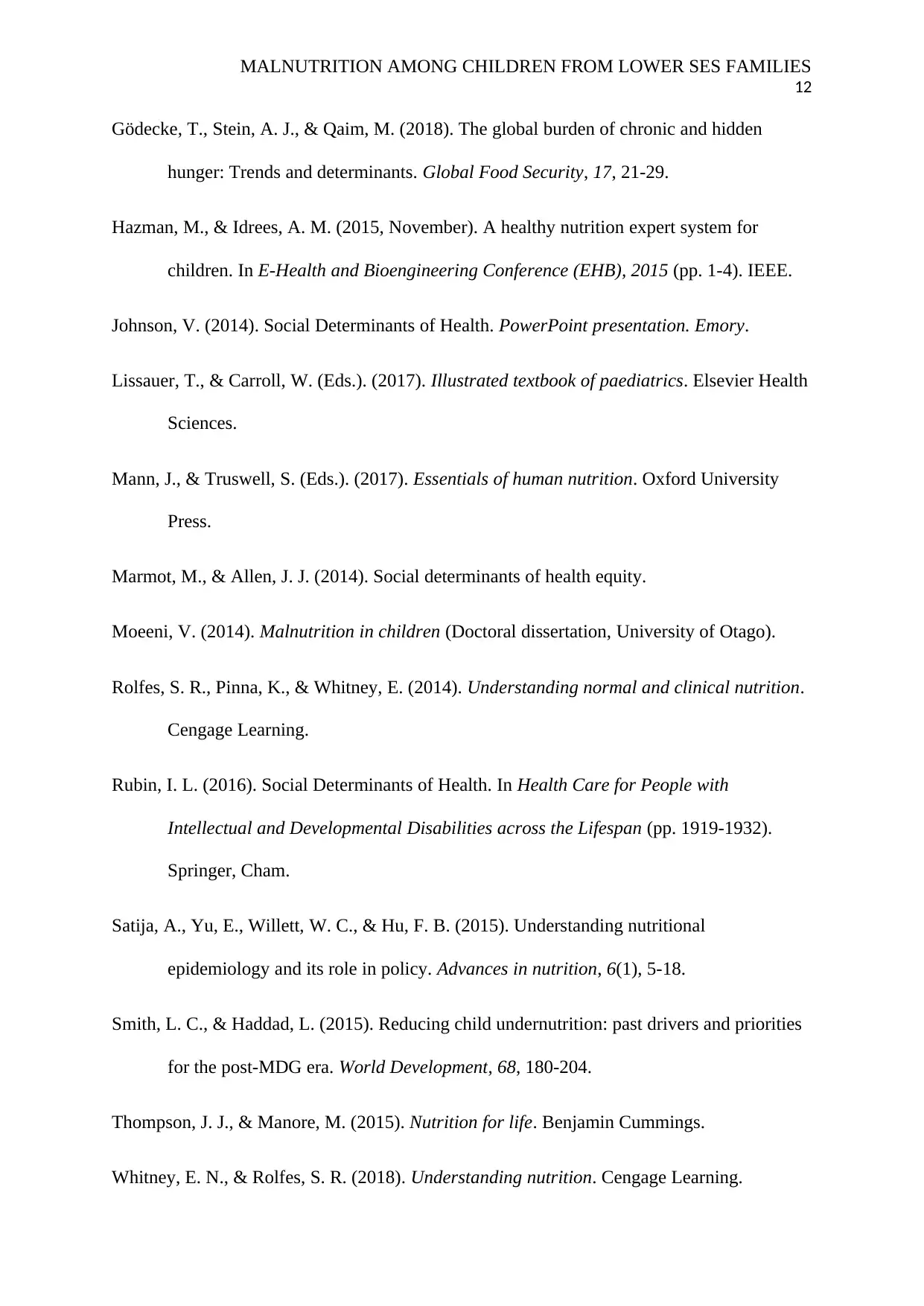
MALNUTRITION AMONG CHILDREN FROM LOWER SES FAMILIES
12
Gödecke, T., Stein, A. J., & Qaim, M. (2018). The global burden of chronic and hidden
hunger: Trends and determinants. Global Food Security, 17, 21-29.
Hazman, M., & Idrees, A. M. (2015, November). A healthy nutrition expert system for
children. In E-Health and Bioengineering Conference (EHB), 2015 (pp. 1-4). IEEE.
Johnson, V. (2014). Social Determinants of Health. PowerPoint presentation. Emory.
Lissauer, T., & Carroll, W. (Eds.). (2017). Illustrated textbook of paediatrics. Elsevier Health
Sciences.
Mann, J., & Truswell, S. (Eds.). (2017). Essentials of human nutrition. Oxford University
Press.
Marmot, M., & Allen, J. J. (2014). Social determinants of health equity.
Moeeni, V. (2014). Malnutrition in children (Doctoral dissertation, University of Otago).
Rolfes, S. R., Pinna, K., & Whitney, E. (2014). Understanding normal and clinical nutrition.
Cengage Learning.
Rubin, I. L. (2016). Social Determinants of Health. In Health Care for People with
Intellectual and Developmental Disabilities across the Lifespan (pp. 1919-1932).
Springer, Cham.
Satija, A., Yu, E., Willett, W. C., & Hu, F. B. (2015). Understanding nutritional
epidemiology and its role in policy. Advances in nutrition, 6(1), 5-18.
Smith, L. C., & Haddad, L. (2015). Reducing child undernutrition: past drivers and priorities
for the post-MDG era. World Development, 68, 180-204.
Thompson, J. J., & Manore, M. (2015). Nutrition for life. Benjamin Cummings.
Whitney, E. N., & Rolfes, S. R. (2018). Understanding nutrition. Cengage Learning.
12
Gödecke, T., Stein, A. J., & Qaim, M. (2018). The global burden of chronic and hidden
hunger: Trends and determinants. Global Food Security, 17, 21-29.
Hazman, M., & Idrees, A. M. (2015, November). A healthy nutrition expert system for
children. In E-Health and Bioengineering Conference (EHB), 2015 (pp. 1-4). IEEE.
Johnson, V. (2014). Social Determinants of Health. PowerPoint presentation. Emory.
Lissauer, T., & Carroll, W. (Eds.). (2017). Illustrated textbook of paediatrics. Elsevier Health
Sciences.
Mann, J., & Truswell, S. (Eds.). (2017). Essentials of human nutrition. Oxford University
Press.
Marmot, M., & Allen, J. J. (2014). Social determinants of health equity.
Moeeni, V. (2014). Malnutrition in children (Doctoral dissertation, University of Otago).
Rolfes, S. R., Pinna, K., & Whitney, E. (2014). Understanding normal and clinical nutrition.
Cengage Learning.
Rubin, I. L. (2016). Social Determinants of Health. In Health Care for People with
Intellectual and Developmental Disabilities across the Lifespan (pp. 1919-1932).
Springer, Cham.
Satija, A., Yu, E., Willett, W. C., & Hu, F. B. (2015). Understanding nutritional
epidemiology and its role in policy. Advances in nutrition, 6(1), 5-18.
Smith, L. C., & Haddad, L. (2015). Reducing child undernutrition: past drivers and priorities
for the post-MDG era. World Development, 68, 180-204.
Thompson, J. J., & Manore, M. (2015). Nutrition for life. Benjamin Cummings.
Whitney, E. N., & Rolfes, S. R. (2018). Understanding nutrition. Cengage Learning.
⊘ This is a preview!⊘
Do you want full access?
Subscribe today to unlock all pages.

Trusted by 1+ million students worldwide
1 out of 13
Related Documents
Your All-in-One AI-Powered Toolkit for Academic Success.
+13062052269
info@desklib.com
Available 24*7 on WhatsApp / Email
![[object Object]](/_next/static/media/star-bottom.7253800d.svg)
Unlock your academic potential
Copyright © 2020–2025 A2Z Services. All Rights Reserved. Developed and managed by ZUCOL.




